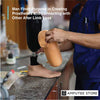Robotic Prosthetic Ankles Can Restore Wide Range of Functions
Although many lower-limb prosthetic users have autonomous control over their prostheses, they still can't do certain functions, like standing still on tricky surfaces or squatting to pick up something off the ground. However, this may soon be a thing of the past. A team of researchers recently discovered that neural control of a robotic prosthetic ankle could restore a wide range of functions in prosthesis users.

Researchers from the University of North Carolina at Chapel Hill and North Carolina State University wanted to determine what happens if an amputee wore a neural-controlled robotic prosthetic ankle while training with a physical therapist on typically challenging activities with standard prosthetic limbs. They wondered if regaining a fuller range of control is possible for amputees on top of walking.
To find the answers to their questions, the team conducted various tests using neural controlled assistive devices, which respond to electrical signals from a prosthetic user's muscles. They sought to determine if these devices allow lower-limb amputees to move naturally and intuitively in their prosthetic legs.
This work is fascinating because it shows that with the help of the right technologies, prosthesis users can gain significant function over using traditional prosthetic feet and ankles.
The test
The research team used robotic prosthetic ankles to scan electrical signals from two calf muscles in the residual limb. These muscles are primarily responsible for controlling ankle motion. Meanwhile, a control paradigm was embedded in the prosthetic ankle to convert electrical signals from the muscles into commands that control prosthetic limb movement.
The team enlisted a below-knee amputee tester. The patient had five training sessions with a physical therapist, lasting about two hours for two-and-a-half weeks.
After the training sessions, the team found that the tester could now do various tasks that had been previously difficult to do, such as squatting or transitioning from a sitting to a standing position without any external assistance.
Besides successfully carrying out these tasks, one of the most pronounced improvements was the user's stability, whether he was moving or standing. The researchers tested his stability on various surfaces, including standing on foam. Most importantly, when asked how confident he was in his level of stability, the study participant gave a high score.
The researchers are preparing to test on more participants. A real-world beta test is also in the pipeline.
Possible insurance coverage
Besides better functionality, the study's authors said that this work could be instrumental in convincing insurance companies to cover robotic prosthetic limbs in the future. They said that more insurance companies would more likely cover expensive robotic prosthetic devices, especially if the technology can dramatically improve an individual's quality of life and community participation.
Here's to hoping that will finally come true.









































































